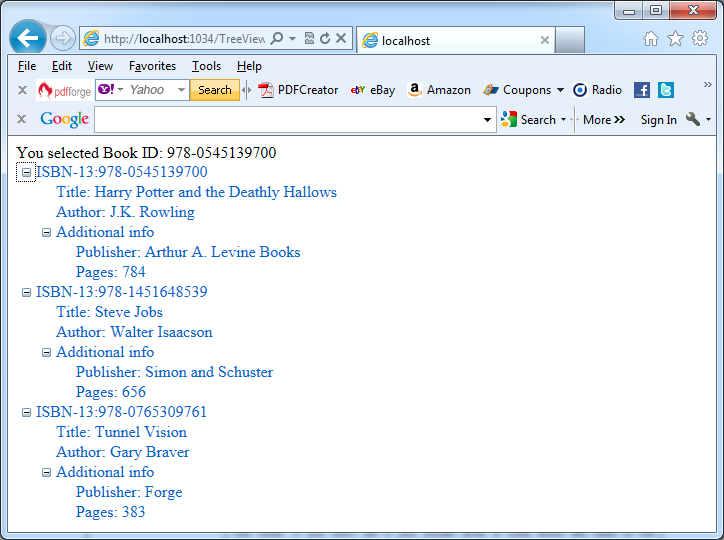Vb Net Treeview File
. Introduction What is the MBTreeViewExplorer? This is a simple TreeView derived control which uses the Windows Explorer interface. It provides no added functionality aside from the standard TreeView control methods, properties, and events, however it does provide a Shell Item class, which can be used to extend this basic example for your own needs, and it is also a good starting point for those wanting to get to grips with the system image list and Shell32 programming. Background MBTreeViewExplorer is an explorer which inherits all the properties of simple TreeView control. The language used is VB.NET.
Hi, As an autodidact I am trying to get the hang of VB.net. Wrote some code to search file and folders in folder and subfolders, and write result to a Listbox. This works great for a Folder on C drive. But On other folders It doesn't. I have lookes ad pemissions ans set them all ( admin, system, user) to full control. Today in VB.NET, i will teach you on how to create a program that loads and displays the directory structure of C using the TreeView control in VB. In Visual Basic for this tutorial by following the following steps in Microsoft Visual Studio: Go to File, click New Project, and choose Windows Application.

Parts of the code are based on other CodeProject tutorials and code samples found elsewhere on the Internet. All of the code was written by me but some of the concepts are from other references and books. What I think is best about this program:. It is a simple design, which should help you to learn how to use the TreeView control. Compared with many of the other sample or demo programs available, it loads directories fast!. The program only loads the necessary folders.
Here are only two events, and one method which drives the MBTreeViewExplorer control. Code The concept for this MBTreeViewExplorer came from the Windows Explorer. MBTreeViewExplorer consists of four classes, ShellAPI, Shell Item, ShellDLL and SystemImageList. @Bhoir, Are the following additional apperently similar sources familiar to You? Jim Parsells 2007, + Calum McLellan 2005, + Steve McMahon, Your code appears to cripple the work of someone else because it is full of functions never invoked, but functions that can be found formulated exactly in the same words but where they were actually working, in older sources than yours. I somehow feel that i wasted my time reading your copy that was missing to give the credits to the original authors.
Vb.net Treeview Files And Folders
It is a relevant question - What is your original contribution? Best Regards, Bruun Last Visit: 31-Dec-99 19:00 Last Update: 17-Dec-17 0:54 1 General News Suggestion Question Bug Answer Joke Praise Rant Admin Use Ctrl+Left/Right to switch messages, Ctrl+Up/Down to switch threads, Ctrl+Shift+Left/Right to switch pages.
This tutorial is part of a series: Part 2 In Part 1 of this tutorial series, I presented a way to use the.NET TreeView control as a file browser similar to Windows Explorer in functionality. As we navigate through this TreeView, the BeforeExpand event is handled so that each node is dynamically populated as soon as it gets expanded.
The second part of this tutorial focuses on displaying the native system icons for each file and folder in the TreeView. Getting Started We will continue building upon the TreeView File Browser Component from Part 1. Open the project and let’s get started. Implement SHGetFileInfo Add a new Module to your project. It should have the default name of Module1.vb. A single folder icon consists of several images SHGetFileInfo needs to know whether we are requesting an icon at all (because we can actually request things other than an icon). It also needs to know whether it is a small icon (16×16), a large icon (full size), as well as whether the icon is in the open state (such as when a folder appears open in Windows Explorer), so we have defined the constants for these (line 3-6).
Vb.net Treeview File Explorer
Furthermore, the SHGetFileInfo needs something to store the result of our request (in this case, the icon), so we must supply it with an SHFILEINFO structure (line 8-16). Create a wrapper function to make using SHGetFileInfo easier The important thing to understand about Win32 API calls is that they sometimes do not return values in the exact format we need them in. For example, SHGetFileInfo does not return a simple System.Drawing.Image or System.Drawing.Icon that we can use immediately in.NET code. Therefore, we will have to extract the returned values from the SHFILEINFO structure and convert them into the desired.NET objects. Basically, we need a wrapper function. The wrapper function should call SHGetFileInfo, extract the icon from the SHFILEINFO structure and convert it to a System.Drawing.Image, then return the System.Drawing.Image. GetShellIconAsImage will be our wrapper function that wraps up the logic which will make this all happen.